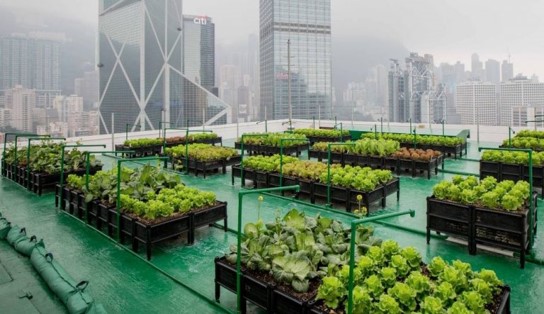Urban Farming 2.0: How Rooftop Gardens Are Changing City Life
In the concrete jungles of the 21st century, where skyscrapers stretch toward the clouds and every square meter of land has a price tag, a quiet green revolution is taking place above our heads. Rooftop gardens — once a niche experiment for eco-enthusiasts — have become a global urban movement, reshaping how cities grow food, cool buildings, and connect communities.
This is Urban Farming 2.0 — not just a trend, but a reinvention of how urban dwellers think about nature, sustainability, and self-reliance.
The Roots of a Sky-High Revolution
Urban farming isn’t new. For centuries, people cultivated vegetables and herbs within city walls — from the hanging gardens of Babylon to wartime “Victory Gardens” in the 1940s. But what we’re seeing today goes far beyond survival gardening.
Rooftop agriculture has evolved into a dynamic ecosystem of innovation, merging technology, architecture, and community design. The modern city is no longer a sterile grid of glass and steel; it’s becoming a living, breathing organism — one rooftop at a time.
Why rooftops?
Because they’re everywhere. In New York City alone, more than 40,000 acres of rooftop space remain underused. The same holds true in London, Tokyo, and São Paulo. Transforming even a fraction of that space into productive green zones could dramatically improve urban food systems and reduce environmental footprints.
But the real power of rooftop farming lies not only in food production — it’s about reclaiming the city as a shared, livable environment.
How Rooftop Gardens Work — and Why They Matter
From hydroponic towers to soil-based micro-farms, rooftop gardens come in many forms. Some are small community plots tended by neighbors; others are highly automated greenhouses feeding entire neighborhoods.
They share a few essential goals: grow locally, waste less, and live better.
1. Environmental Benefits
Urban heat islands — zones of higher temperature caused by dense construction — are a growing problem. Rooftop gardens help counteract this effect by absorbing heat, improving insulation, and reducing air-conditioning use. According to a 2023 study from the European Environment Agency, green roofs can lower surrounding air temperatures by up to 2°C during heatwaves.
They also reduce stormwater runoff, absorb carbon dioxide, and improve air quality. In a time when cities are choking on smog, a layer of vegetation can act like the planet’s lungs.
2. Economic and Social Impact
Rooftop farming brings financial as well as social value. Buildings with green roofs often see energy savings of 20–30%, while communities benefit from fresh, local produce.
In densely populated areas, where farmers’ markets and gardens are rare, rooftop farms restore a sense of local food sovereignty. They reconnect people with where their food comes from and reduce dependence on long supply chains vulnerable to climate disruptions.
3. Mental and Community Well-being
Beyond data and economics lies something deeper — a reconnection with nature. Studies show that exposure to greenery, even small patches, lowers stress, improves concentration, and boosts happiness. In cities like Seoul or Paris, rooftop gardens have become social spaces — hosting workshops, yoga sessions, and school projects.
They create what sociologists call “third places” — spaces that are neither home nor work, but essential for community life.
Comparing Rooftop Farming Models Around the World
| City / Region | Model | Unique Feature | Key Benefit |
|---|---|---|---|
| New York, USA | Commercial rooftop farms (e.g., Gotham Greens) | Hydroponic greenhouses powered by solar panels | Local food for supermarkets, lower transport emissions |
| Paris, France | Urban agriculture integrated into architecture | City law requires green roofs on all new buildings | Climate resilience and visual beautification |
| Tokyo, Japan | Corporate rooftop gardens | Managed by companies for employee wellness | Reduces stress, improves air quality |
| Singapore | Vertical rooftop farms | Part of national “30 by 30” food strategy | High-tech automation and efficient land use |
| Nairobi, Kenya | Community-led micro-farms | Low-cost materials and local compost | Empowerment and income for low-income families |
These examples reveal that rooftop farming is not a one-size-fits-all model — it adapts to each city’s culture, economy, and climate. Whether it’s New York’s commercial hydroponics or Nairobi’s grassroots composting projects, the essence is the same: make cities fertile again.
Technology Meets Ecology: The Rise of Smart Rooftops
Urban Farming 2.0 isn’t just about shovels and soil; it’s about data, sensors, and design. The digital revolution has enabled urban agriculture to scale efficiently without losing its ecological purpose.
1. Hydroponics and Aquaponics
These systems grow plants without soil, using nutrient-rich water that circulates through closed loops. They consume up to 90% less water than traditional farming — an essential advantage for drought-prone cities like Los Angeles or Dubai.
Aquaponic systems go a step further by combining fish farming and plant cultivation, creating a symbiotic mini-ecosystem that recycles waste and nutrients.
2. Smart Monitoring Systems
Sensors and IoT technologies now allow urban farmers to track soil moisture, temperature, and light levels in real time. Apps can automatically adjust watering schedules, reducing waste and maximizing yield.
This data-driven approach means even small rooftop farms can operate with near-industrial efficiency — but without the environmental toll.
3. Sustainable Design Integration
Architects are increasingly designing buildings with green infrastructure in mind. Modern rooftop gardens are not afterthoughts; they are integral parts of construction. Waterproof membranes, lightweight soil mixes, and irrigation systems are built in from the start.
Cities like Copenhagen and Toronto now require or incentivize green roofs in all new public buildings — setting the stage for more sustainable urban landscapes.
Challenges and Criticisms — The Growing Pains of Green Cities
Like any innovation, rooftop farming faces obstacles. For every lush garden on a penthouse, there are logistical, legal, and environmental challenges to overcome.
1. Structural and Financial Barriers
Not every rooftop can handle the weight of soil, water, and crops. Retrofitting old buildings can be expensive, and maintenance costs may deter small property owners. Insurance and liability issues further complicate things.
However, governments are starting to respond. Cities like Toronto and Berlin offer tax breaks and subsidies for green roofs, recognizing their long-term environmental value.
2. Equity and Access
There’s a risk that rooftop farming becomes a privilege of the affluent — visible atop luxury condos, inaccessible to those in lower-income areas. Critics argue that urban farming must not just be aesthetic, but inclusive.
Some of the most inspiring projects address exactly that. In Detroit and Cape Town, community-led rooftop gardens have turned abandoned buildings into collective farms — providing jobs, education, and fresh produce where supermarkets once fled.
3. Scaling Up Without Selling Out
As investment flows in, the question arises: can rooftop farming stay true to its ecological roots, or will it become another commercial trend? The key lies in balancing profit and purpose.
For example, Gotham Greens in the U.S. runs rooftop greenhouses that supply major grocery chains, but they also invest in local food education and donate surplus produce. The future of Urban Farming 2.0 depends on such hybrid models — combining innovation with community benefit.
Beyond Food: The Cultural and Psychological Shift
Urban farming is about much more than growing lettuce in the sky. It’s a cultural statement — a reclaiming of space, identity, and agency in the modern city.
Reclaiming the Rhythm of Nature
When city residents start planting and harvesting, they reconnect with the cycles of growth and decay — a rhythm often lost in the digital age. It’s a quiet rebellion against the instant gratification of urban consumerism.
As one Tokyo rooftop gardener put it:
“Tending my tomatoes teaches me patience. Watching them ripen reminds me that good things take time.”
Education and Future Generations
Schools are incorporating rooftop gardens into their curricula, teaching biology, sustainability, and teamwork in one living classroom. In Chicago, The Academy for Global Citizenship uses its rooftop farm to teach children about soil ecosystems, food justice, and climate change — turning education into experience.
City Identity and Aesthetic Renewal
Green roofs also reshape urban identity. The image of the gray, polluted metropolis is being replaced by biophilic cities — places where architecture and ecology coexist.
Copenhagen’s “green corridors,” Paris’s rooftop vineyards, and Seoul’s “Urban Forest” projects prove that beauty, sustainability, and productivity can align.
A Look Ahead: Cities as Living Ecosystems
Urban Farming 2.0 represents a deeper philosophical shift — from conquering nature to coexisting with it. The line between urban and rural is fading, giving rise to hybrid landscapes that feed both body and soul.
Future cities may feature stacked ecosystems: rooftop orchards, vertical aquaponic walls, and green terraces connected by pollinator corridors. Imagine walking through a city where the scent of basil drifts from the rooftops, and drones deliver strawberries grown three blocks away.
But technology alone isn’t enough. The true success of this movement depends on community ownership, inclusive design, and education. Every rooftop garden is not just a piece of infrastructure — it’s a story of human adaptation, creativity, and care.
Conclusion: From Gray to Green
Urban Farming 2.0 is more than a trend — it’s a vision of what cities could be if we choose connection over consumption. Rooftop gardens symbolize a new social contract between humans and their environment: we give space, and nature gives back abundance.
Each seed planted above the skyline is a reminder that sustainability begins at the local level. Whether it’s a single herb box on an apartment balcony or a hectare of hydroponics on a warehouse roof, every initiative counts.
Cities of the future won’t just house people — they’ll feed them, heal them, and inspire them.
And maybe, as we look up at the green rooftops of tomorrow, we’ll realize that the most fertile ground has always been right above us.




